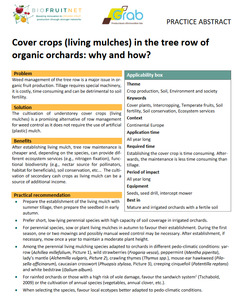{Tool} Cover crops (living mulches) in the tree row of organic orchards: why and how? (BIOFRUITNET Practice Abstract). Creator(s): Jacquot, Maxime and Parveaud, Claude-Eric. Issuing Organisation(s): GRAB - Groupe de Recherche en Agriculture Biologique. Biofruitnet Practice Abstract, no. 079. (2022)
|
PDF
- Published Version
- English
(Cover crops (living mulches) in the tree row of organic orchards: why and how?)
511kB | |
|
PDF
- Published Version
- French/Francais
(Les plantes de couverture dans les rangs des vergers biologiques : pourquoi et comment ?)
506kB | |
|
PDF
- Published Version
- German/Deutsch
(Baumstreifenbegrünung mit Deckfrüchten in ökologischen Obstanlagen: Warum und wie?)
550kB | |
![[thumbnail of 2024-05-13 10_28_13-Cover crops (living mulches) in the tree row of - 79_PA_BIOFRUITNET_Final.pdf – .png]](/44786/7.hassmallThumbnailVersion/2024-05-13%2010_28_13-Cover%20crops%20%28living%20mulches%29%20in%20the%20tree%20row%20of%20-%2079_PA_BIOFRUITNET_Final.pdf%20%E2%80%93%20.png)  Preview |
Image (PNG)
- Cover Image
- English
117kB |
Document available online at: https://orgprints.org/44786
Summary in the original language of the document
After establishing living mulch, tree row maintenance is cheaper and, depending on the species, can provide different ecosystem services (e.g., nitrogen fixation), functional biodiversity (e.g., nectar source for pollinators, habitat for beneficials), soil conservation, etc... The cultivation of secondary cash crops as living mulch can be a source of additional income.
Practical recommendation
• Prepare the establishment of the living mulch with summer tillage, then prepare the seedbed in early autumn.
• Prefer short, low-lying perennial species with high capacity of soil coverage in irrigated orchards.
• For perennial species, sow or plant living mulches in autumn to favour their establishment. During the first season, one or two mowings and possibly manual weed control may be necessary. After establishment, if necessary, mow once a year to maintain a moderate plant height.
• Among the perennial living mulching species adapted to orchards in different pedo-climatic conditions: yarrow (Achillea millefolium, Picture 1), wild strawberries (Fragaria vesca), peppermint (Mentha piperita), lady’s mantle (Alchemilla vulgaris, Picture 2), crawling thymes (Thymus spp.), mouse-ear hawkweed (Pilosella officinarum), caucasian crosswort (Phuopsis stylosa, Picture 3), creeping cinquefoil (Potentilla reptans) and white bedstraw (Galium album).
• For rainfed orchards or those with a high risk of vole damage, favour the sandwich system (Tschabold, 2009) or the cultivation of annual species (vegetables, annual clover, etc.).
• When selecting the species, favour local ecotypes better adapted to pedo-climatic conditions.
| EPrint Type: | Practice tool |
|---|---|
| What problem does the tool address?: | Weed management of the tree row is a major issue in organic fruit production. Tillage requires special machinery, it is costly, time consuming and can be detrimental to soil fertility. |
| What solution does the tool offer?: | The cultivation of understorey cover crops (living mulches) is a promising alternative of row management for weed control as it does not require the use of artificial (plastic) mulch. |
| Country: | France |
| Type of Practice Tool: | Practice abstracts |
| Keywords: | Cover plants, Intercropping, Temperate fruits, Soil fertility, Soil conservation, Ecosystem services |
| Agrovoc keywords: | Language Value URI English cover plants http://aims.fao.org/aos/agrovoc/c_1936 English intercropping http://aims.fao.org/aos/agrovoc/c_3910 English temperate fruits http://aims.fao.org/aos/agrovoc/c_7655 English soil fertility http://aims.fao.org/aos/agrovoc/c_7170 English soil conservation http://aims.fao.org/aos/agrovoc/c_7165 English ecosystem services http://aims.fao.org/aos/agrovoc/c_1348040570280 |
| Subjects: | Environmental aspects > Biodiversity and ecosystem services Crop husbandry > Production systems > Fruit and berries Crop husbandry > Weed management |
| Research affiliation: | European Union > Horizon 2020 > Biofruitnet France > GRAB - Groupe de Recherche en Agriculture biologique European Union > Organic Farm Knowledge |
| Horizon Europe or H2020 Grant Agreement Number: | 862850 |
| Related Links: | https://organic-farmknowledge.org/tool/44786, https://biofruitnet.eu, https://x.com/farm_knowledge/status/1881387685367202163, https://www.facebook.com/organicfarmknowledge/posts/pfbid024M1xKN9ZYt1xMWbkVPGg9QwhWKLdz8dEdmwqtZRRm48UBeHonod9nbfoMHau11C9l |
| Project ID: | ofk |
| Deposited By: | Basler, Andreas |
| ID Code: | 44786 |
| Deposited On: | 10 Dec 2022 17:11 |
| Last Modified: | 20 Jan 2025 17:19 |
| Document Language: | English, German/Deutsch, French/Francais |
| Status: | Published |
Repository Staff Only: item control page


